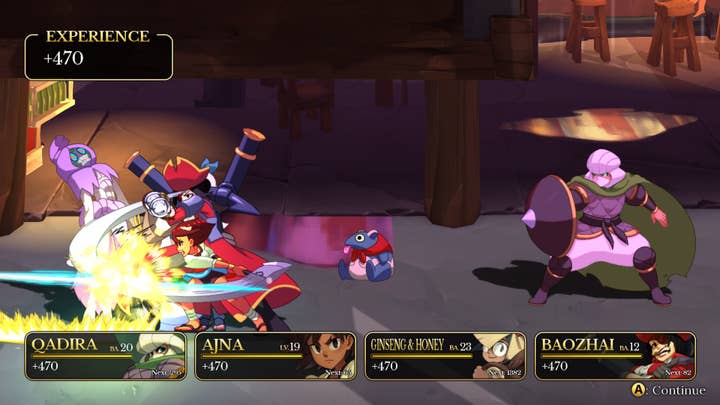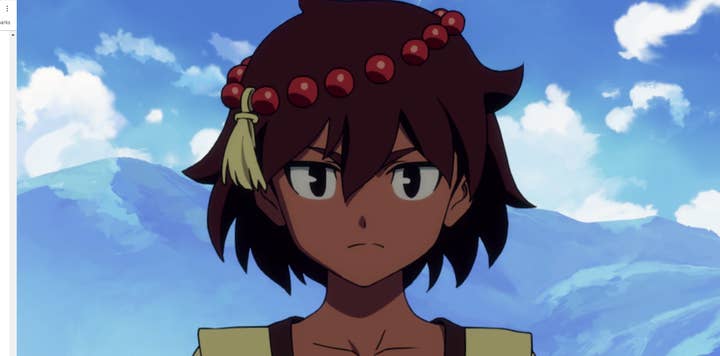Lab Zero Games: From killer girls to inner worlds
Creative director Mariel Cartwright talks about Indivisible's cultural inspirations and the challenges of crowdfunding bigger games
When Lab Zero Games moved from working on Skullgirls to Indivisible, it left behind '40s post-war America, competitive play, and fighting games in favor of Southeast Asia, single-player, and the RPG genre.
However, it brought with it a penchant for making tough, curious, often magical young women the stars of the story. The heart of Indivisible is its protagonist, Ajna, a girl who suffers an inciting tragedy that sends her on a journey across a fictional world inspired by Southeast Asian mythology and culture. And while the gameplay naturally takes the player through her outward, physical journey, there's a heavy emphasis on her inner, spiritual journey and growth.
None of these departures, according to creative director Mariel Cartwright, are conscious attempts to get away from the studio's previous work. Speaking to GamesIndustry.biz at PAX West, Cartwright frames Indivisible's unique design, world, and inspiration as simply decisions and ideas that felt natural to the team.
"We all loved working on Skullgirls, but not everyone on the team is a fighting game player," she says. "We all wanted to work on something we could all play together when we were finished making it. The genre we thought we could do that with was an RPG, so we set out to create the world and setting.
"Our designer had the idea of taking inspiration from the game Valkyrie Profile and taking that battle system, twisting it, making it a little different, making the platforming a bit more Metroidvania. He had all these ideas about how this game would play, and the artists worked on the lore, world, characters and settings, and we combined all of it and that's what Indivisible is."
"We see a lot of Western European-inspired games, we see a lot of East Asian, but we don't see games take inspiration from Southeast Asia very often"
Though Cartwright describes Indivisible as a bit of a mishmash, its inspirations are clear. The Metroidvania exploration and platforming pauses for RPG-style battles with enemies, but your combat methods are, as Cartwright said, Valkyrie Profile-esque but still reminiscent of the fighting in Skullgirls. There's a lot happening in Indivisible, but it's all unified by its aesthetic. Everything from its lore to its enemies to its setting are heavily steeped in the culture and history and mythology of a region of the world that isn't often represented in Western games, much less put in the spotlight as it is in Indivisible.
"We see a lot of Western European-inspired games, we see a lot of East Asian, but we don't see games take inspiration from Southeast Asia very often," Cartwright says. "The beautiful culture, beautiful mythology, stories, and folklore... and our game is very fantasy. We're not trying to say our game is from that part of the world, but in terms of what we were researching and drawing inspiration from, it's not something we often see.
"We're a majority-Asian team, our artists are majority-Asian, so we wanted to tell a story that felt a little closer to us and wasn't necessarily about our struggles, but was something that felt closer to home in terms of how we interact with people. Ajna's dad is a very stern, gruff guy -- he doesn't really express himself a lot, and I think that's something a lot of Asian people I know experience in their own lives. It's small touches like that that people can relate to -- different audiences can relate to this than what we typically see."
Indivisible may be centered around Ajna, but it also hosts a broad cast of other characters and party members, each with their own unique inspirations and quirks. Cartwright says that while the result is a diverse group of companions that represent the variety of the region that inspired them, that diversity also wasn't necessarily a deliberate decision made during development.

"Diverse characters aren't something I'm consciously thinking about, but it feels natural to me. I do know other people notice, because they say 'You have a very diverse cast.' Well, there are diverse people in the world. That's what we want. It's a conscious subconscious thing."
Though it wasn't specifically the goal, Cartwright adds that the reception to the game's style, inspiration, and diversity has been overwhelmingly positive.
"I really appreciate when I see someone from Southeast Asian descent come to me and say 'I'm so excited that you did this because we never see this,'" she says. "The reception has been really positive. It's been a long time, so sometimes it's hard to see it because you have your head down for so long working on it."
Indivisible has been in development for around four years, a year longer than originally planned. Cartwright says some of that is due to the complexity of a fighting game team switching to an RPG game, adding that environments especially were tough to adjust to.
"Other people say, 'You have a very diverse cast.' Well, there are diverse people in the world!"
"Doing an environment in a fighting game, you just have the one stage," she says. "We usually approach that by having a painter do a painting of the background, then we have a 3D artist split it up. It's layered illustrations. But for this we had to develop a whole pipeline to create real environments. That took the entire time of development basically, but we have an amazing environment team now. We let them inject a ton of personality into creating different rooms."
The longer development cycle meant that the studio exhausted its original IndieGoGo crowdfunding money, but a publisher, 505 Games, was willing to support the project to its conclusion. And despite the challenges, the 16 person team is at last on the cusp of releasing its approximately 30 hour RPG next month. Afterward, Cartwright says that Lab Zero is ready to grow. They want to keep doing longer, meatier games in the vein of Indivisible, and maybe even start working on developing two games at once instead of just one.
"We've been around for seven years, but if you count the Skullgirls DLC as half a game, and Indivisible isn't out yet, well, we don't want to be a studio that only puts out one game every five years."
I ask Cartwright if that would mean a return to crowdfunding, but she replies that given the size of their ambitions, that's no longer realistic.
"Our projects might be too expensive for crowdfunding now, because I think we want to keep growing and expanding our company and we don't want to keep coming back to our community and saying 'Give us several million dollars.' That's not going to happen. If we do a smaller project we'd consider it, but if we're looking at our next Indivisible or Skullgirls-sized game I don't think we'll go that route.
"But it is really hard to crowdfund. It's really stressful. There's this extra layer of management you have to do, communicating with your backers, making sure you're open, and while obviously we couldn't have done any of our projects without our backers, it is an extra layer of stuff to do and game development is already so hard on its own. We're not against the idea, but I think we want to explore another publisher-developer route, or if Indivisible does well enough we could start funding our own small projects."
Disclosure: PAX organizer ReedPOP is the parent company of GamesIndustry.biz.

